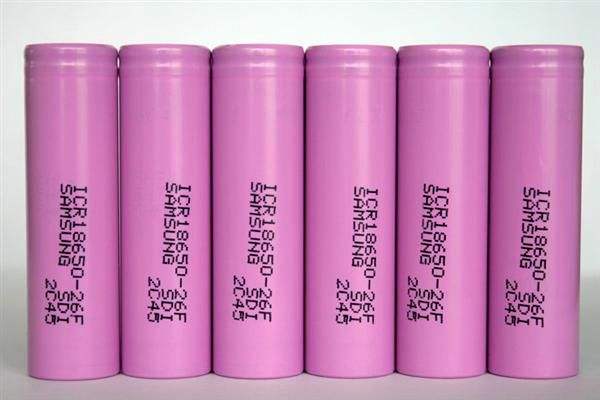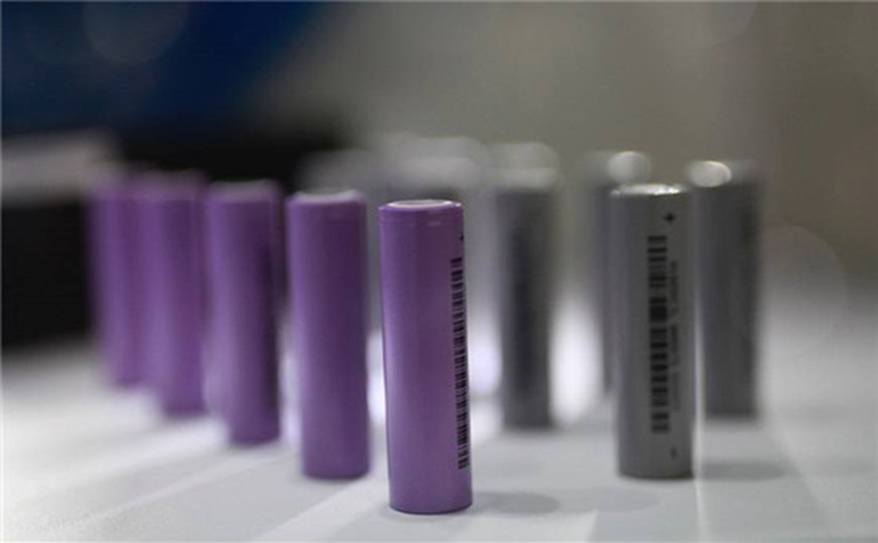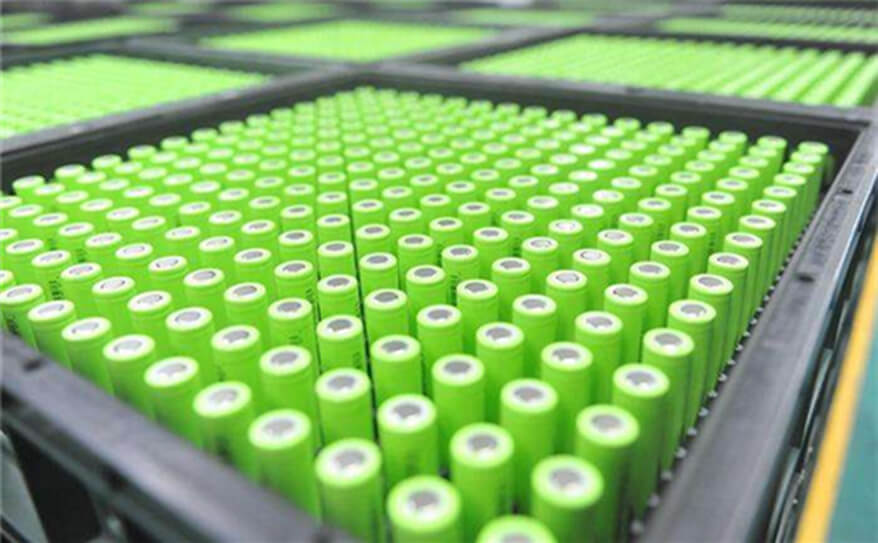Fairly comprehension of 18650 lithium ion battery
May 10, 2019 Pageview:1290
Over 300 years ago, Benjamin Franklin tried to study the thunder. From then on, people gradually knew more about electricity and considered how to storage it. Day by day, battery was finally invented. As a historic essential invention, battery does solve different kinds of issues and improve our quality of life. The invention of lithium ion battery helps people know even more about electricity. 18650 lithium ion battery has been used for a long time, it may be the first and latest lithium ion battery. It is very durable and safe compared with other battery. 18650 lithium ion battery is even used in large-scale equipment. There will be more details in following part for 18650 lithium ion battery and the reason of explosion.

18650 lithium ion battery
The advantages of 18650 lithium ion battery
Generally, it is believed that the battery has been run out of electricity if the no-load voltage is less than 3.0V (need to check the threshold value on battery protection board, may be 2.8V or even 3.2V). Threshold value of most of the lithium ion battery cannot make the no-load voltage lees than 3.2V, otherwise, over-discharging will destroy the battery. (in general, the protection board can’t detect and charge the battery if there is no protection board with the battery)
4.2V is the highest limited voltage of battery charging. When the no-load voltage of the lithium ion battery reaches 4.2V, it means the battery is fully charged. The voltage of battery will gradually rise from 3.7V to 4.2V during battery charging. But lithium ion battery cannot charge over 4.2V, which may result in damage on battery. This is one of the characteristic of lithium ion battery. The advantages of 18650 lithium ion battery are as follow.
1. Wide range of usage
Laptop, interphone, portable DVD, instruments and apparatus, sound equipment, model airplane, toy, camcorder, digital camera, etc.
2. Cascade
Can cascade or parallel connect to 18650 lithium ion battery pack.
3. Small internal resistance
The internal resistance of polymer battery is smaller than liquid one. That of domestic polymer battery can even be under 35mΩ, which can shorten self-consuming and lengthen stand-by time. Polymer battery with large discharge current is the ideal choice of remote control model, and may become the substitute products of NI-MH battery.
4. No memory effect
Don’t need to run out of the remaining capacity. It is very convenient.
5. High voltage
The voltage (3.6V, 3.8V, 4.2V) of 18650 lithium ion battery is far higher than Ni-Cd battery and NI-MH battery with 1.2V.
6. High safety performance
No explosion, no fire, 18650 lithium ion battery has high safety performance. No poison, no pollution, it has passed RoHS trademark certificate. And its cycle number even reaches over 500. What’s more, it also has good high temperature performance with 100% discharging rate at 65℃. To avoid short circuit, its anode and cathode are separate. Adding protection board also helps extend the cycle life of the battery without overcharging and over-discharging.
7. High cycle life
18650 lithium ion battery has long cycle life. Normal value is over 500 times, which is over twice than normal battery.
8. Large capacity
The capacity of 18650 lithium ion battery is 1200mah~3600mah, while that of normal battery is only around 800. If making combination into battery pack, the capacity can easily exceed 5000mah.

18650 lithium ion battery VS polymer battery
Polymer battery is a lithium ion battery using polymer as electrolyte. It can divide into two species: semi-polymer and all-polymer. The semi-polymer is the polymer on the isolating membrane (tend to be PVDF), making stronger adhesive force and hardness with liquid electrolyte. Full-polymer is that make polymer into gel network inside the battery, then add liquid electrolyte to make them together. Although full-polymer battery still needs liquid electrolyte, the dose is limited. It can greatly improve the security performance. Nowadays, only SONY has mass production on full-polymer lithium ion battery.
On the other hand, polymer battery is a lithium ion battery using aluminum plastic film as outer package. It is also called pouch cell. This package film is made of three layers, including PP, AI and nylon. This battery also named polymer battery because PP and nylon are polymer.
1. Lower price
The international price of 18650 is around 1USD/pcs, about 3RMB/Ah according to 2Ah standard. As for polymer lithium ion battery, low-level copycat factory is 4RMB/Ah, the better one is 5~7RMB/Ah, and the top one is over 7RMB/Ah. ATL and Lishen will sell the polymer lithium ion battery at around 1USD/pcs. If the order volume is small, they may refuse your order.
2. No customization
SONY tends to make lithium ion battery as alkaline battery, having a definite industrial standard. For example, No.5 and No.7 battery are definite size all over the world. However, one of the advantages of lithium ion battery is customization for customer on appearance design, so it’s nearly impossible to have a standard of appearance. Basically, only exist one standard type for lithium ion battery (18650) in lithium ion battery industry, the other battery is customized based on customer’s requirements.
3. Poor safety performance
We need to notice that lithium ion battery may have strong chemical reactions inside, and produce plenty of gas under extreme case (overcharge, high temperature, etc.). Owing to the metal outer of 18650, it may cause explosion and safety incidents when the gas accumulates to a certain volume inside the battery.
This is why the test room of 18650 battery needs to isolate carefully, and people are not allow to get into the room. Due to the lower intensity of package film, polymer battery won’t have breakage and explosion under extreme case. Fire is the worse result. So in this respect, polymer battery will be better than 18650 battery.
4. Low energy density
Normally, the capacity of 18650 is around 2200mAh, energy density is about 500Wh/L, while the energy density of polymer battery can reach nearly 600Wh/L at present.
However, polymer battery has a disadvantage of high cost owing to the customization cost. The diverse appearance and types also increase the cost of fixtures. Flexible design results in low commonality of the product. Even a discrepancy of 1mm, we need to re-design for the customer.
The application of 18650 lithium ion battery
The application of lithium ion secondary battery in energy industry benefits from its outstanding performance. With the gradual development of technology, lithium ion secondary battery is widely used in our daily life. Rechargeable battery is more and more popular by the consumer. Paying attention to energy battery industry and trying to know more about battery helps us to enrich application forms. Nowadays, 18650 lithium ion battery is applied in the following field.
1. Energy storage
18650 lithium ion battery is mainly used in power supply of base station, clean energy storage, power grid energy storage, household optical storage system, etc.
2. Electric power
It includes electric vehicles, electric bicycle, new energy automobile, etc.
3. Digital type
Mobile phone, iPad, laptop, electric toy, MP3/MP4, earphone, power bank, model airplane, mobile power, etc.
The category of 18650 lithium ion battery
In order to avoid overcharging and over-discharging, 18650 lithium ion battery needs to prepare with protect circuit during production. This is the essential countermeasure of lithium ion battery weakness. Because Li-Co material is the basic material of lithium ion battery, lithium cobalt oxide battery is not allowed large current charging and its security performance is poor. Above these, 18650 lithium ion battery can be classified by the following method.
1. Classify by practical performance
Power battery and energy battery: energy battery is advanced on high energy density and mainly used for high energy output, while power battery exceed on high power density and mainly used for instant high power output &input. With high requirement, the battery needs to have good energy storage performance, support individual electric working for some distance, and keep a good power characteristic, so as to turn into the hybrid mode under low-power circumstance.
For an analogy, energy battery alike marathon runner with patience, is required for high capacity, but no need to large current discharging. In contrast, power battery is similar with sprinter with instant power and also patience, or it cannot work for long distance without large capacity.
2. Classify by electrolyte material
Lithium ion battery includes liquid lithium ion battery (LIB) and polymer lithium ion battery (PLB).
Recently, most of the power battery is LIB using liquid electrolyte, while PLB uses polymer electrolyte. So the polymer can be dry or colloidal. Nowadays, most of the batteries have polymer gel electrolyte. As for solid-state battery, it actually means both electrode and electrolyte are at solid state.
3. Classify by product appearance
Cylinder battery, pouch battery and square battery
Cylinder and square batteries always are packed by steel shell or aluminum shell. The package of pouch battery is aluminum-plastic film. Pouch battery also has square appearance, but the market tends to regard battery with aluminum-plastic film as pouch battery. Some people even called pouch battery as polymer battery.
The part number of cylinder lithium ion battery tends to be five digits. The first two digits is the diameter of the battery, the middle two is the height of the battery. The unit of measure is millimeter. For an example, 18650 lithium ion battery means a battery with 18mm diameter and 65mm height.
4. Classify by pole piece material
Anode material: lithium iron phosphate battery (LFP), lithium cobalt oxide battery (LCO), lithium manganate battery (LMO), (two-element battery: LNMO/ nickel lithium cobalt oxide), (ternary battery: Li-NiCoMn Lithium ion battery (NCM), Lithium nickel cobalt aluminate battery (NCA)
Cathode material: Lithium titanate battery (LTO), graphene battery, nanometer carbon fiber battery
As for graphene in market, it mainly means graphene-based battery- adding graphene slurry on piece pole, or graphene coating on diaphragm. Lithium nickel batteries and magnesium-based batteries hardly exist in market.
The charge and dis-charge of 18650 lithium ion battery
Accord with industrial standard, the normal capacity of the lithium ion battery is the minimum capacity, which is tested by first fully charging cc/cv 0.5c, after 12-hour maintenance at 25℃ indoor, then discharging by 0.2c current to 3.0V(or 2.75V, both are OK, no big difference between 3V to2.75V). Given that the same batch batteries may have individual differences, the lowest capacity in the test is the normal capacity, so the capacity of any other battery in this batch needs to be bigger than this normal capacity.
1. The charging process of 18650 lithium ion battery
Some charger has poor control precision due to cheap scheme, easily resulting in abnormal charging state and even damaging the battery. In order to lengthen the cycle life of the battery, need to buy 18650 Li-ion battery charger of famous brand with quality and after-sales warranty. This kind of charger has four layers protection: short circuit protection, overcurrent protection, overvoltage protection, battery reversal protection, etc. Overcharge protection: stop charging when overcharge the Li-ion battery, so as to avoid increasing on internal voltage because of the rising temperature.
Monitor the voltage of battery to protect device. Activate overcharge protection function and stop charging when the battery is overvoltage. Overcharge protection: in order to prevent over-discharge of Li-ion battery, activate overcharge protection function, stop charging and maintain standby mode under low quiescent current when the voltage is lower than the detecting point. Over current and short circuit protection: activate over current protection when the Li-ion battery is overcharged or has short circuit.
The charge control of Li-ion battery divides into two stages. The first stage is constant current charge. The charger will charge in constant current when the voltage of the battery is lower than 4.2V. The second stage is constant voltage charge. The charger will control the voltage to 4.2V, lessen the current gradually when the voltage of battery reaches 4.2V, otherwise, the battery will be damaged. When the current lessens to a certain value (normally is 1/10 current setting), cut off the electricity and the indicator light is on, which means charge finished.
Overcharge and over-discharge will lead to permanent damage on anode and cathode. Over-discharge will result in collapse on carbon lamellar structure of cathode, which makes the Li-ion cannot insert during charging. Overcharging causes many Li-ion inset to carbon lamellar structure of cathode and part of the Li-ion cannot go out any more.
2. The charging principle of 18650 lithium ion battery
The charging principle of lithium ion battery is charge and discharge principle. During charging, anode of the battery produce Li-ion, then it runs to cathode along with the electrolyte. Then it insets into the millipore of cathode carbon lamellar structure. The more Li-ion insets into, the higher capacity it is.
In the same way, the Li-ion escapes from the carbon structure of cathode and back to anode during battery discharging (when we use the battery). The more Li-ion in anode, the higher discharging capacity it is. What we called battery capacity refers to discharging capacity.
Obviously, during charging and discharging process, Li-ion moves from anode to cathode, then back to anode. If we regard the Li-ion battery as a rocking chair, two ends of the chair are electrodes of the battery, so the Li-ion is a great sport player running between these two ends. In accordance with this, experts called Li-ion battery rocking-chair battery.

Why does 18650 lithium ion battery have explosive history?
Most of 18650 batteries have steel shell package, but battery without good quality doesn’t have protection function. During overcharging, the inner pressure will increase, and give rise to explosion if over the limit value. Besides, short circuit, high temperature or deformation even breakage will generate explosion.
After 30-year development, 18650 battery manufacture technology has made great progress, especially on capability and safety performance. In order to prevent explosion on sealed metal outer, there is a safety valve on the top of 18650 battery. The safety valve is the standard configuration and anti-explosive assurance of each 18650 battery.
When over pressure inside the battery, open the safety valve outlet on the top of the battery to prevent explosion. However, after opening the outlet, the chemical substances leaked out from the battery will have chemical reaction with oxygen, and even catch fire. Besides, some 18650 batteries have standard configuration of protection board with overcharge & over-discharge and circuit protection function, so that the safety performance is really good.
Most of the power bank explosive accidents before are caused by inferior 18650 batteries produced by the unscrupulous manufacturers for cost saving, and even secondhand batteries. Recently, the 18650 batteries produced by Panasonic, Sony, Samsung etc. are very secure. If we pay more attention to the proper usage during daily life and beware of short circuit, damage or high temperature, there is no need to worry about explosion. We cannot judge a good product only on the negative example.
Summarize: to be honest, nobody can make sure that no accident will happen, but we can believe that the safety performance will be better and better with developed technology. 18650 battery will far widely used in all kinds of fields and become part of our life, because it is a great product.
Leave Message
Hottest Categories
-
Hottest Industry News
-
Latest Industry News









